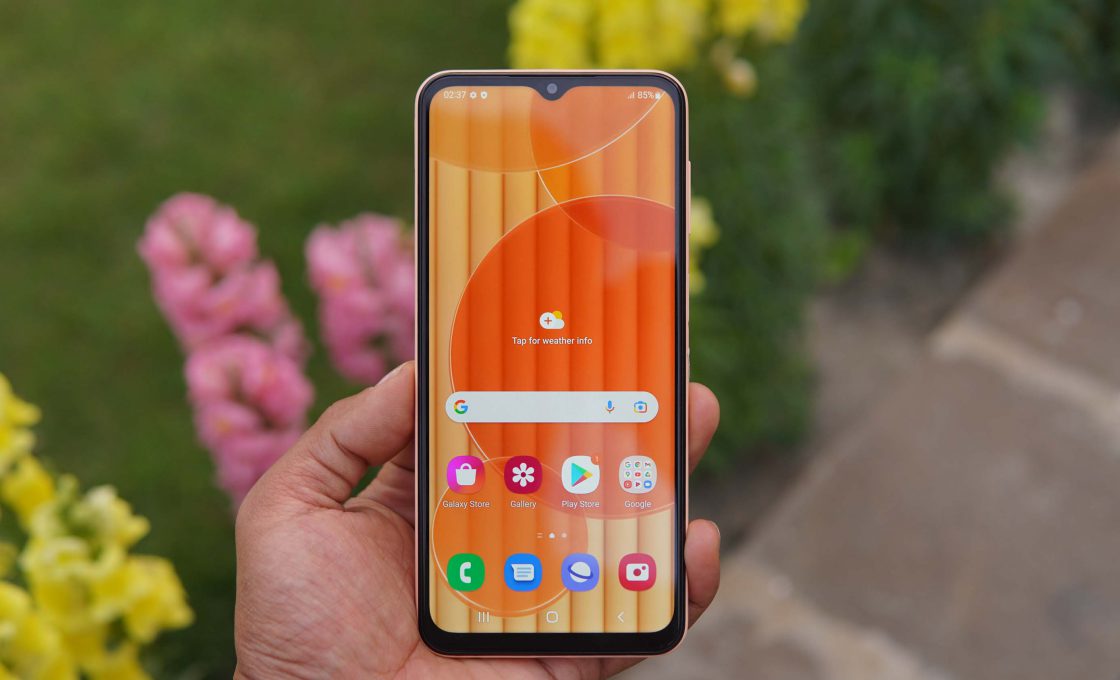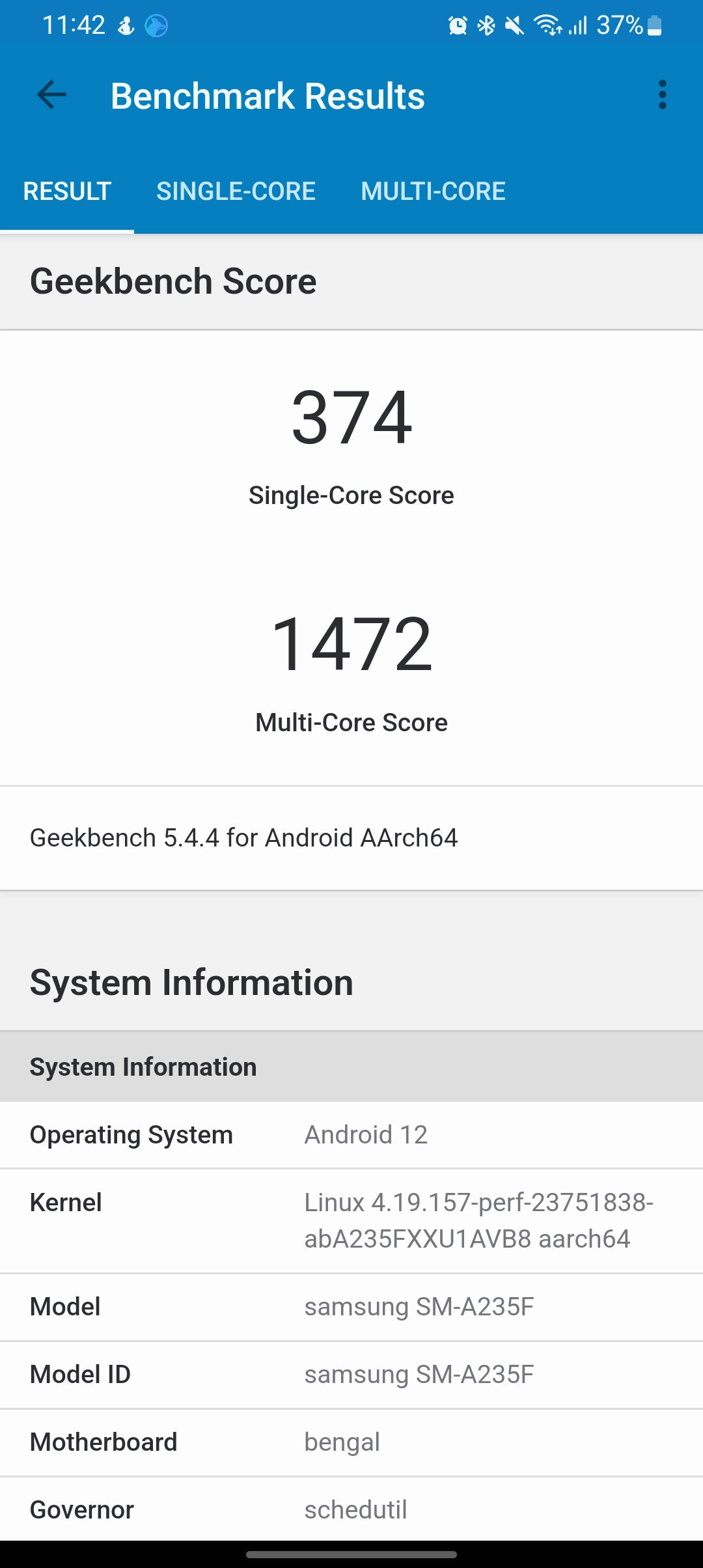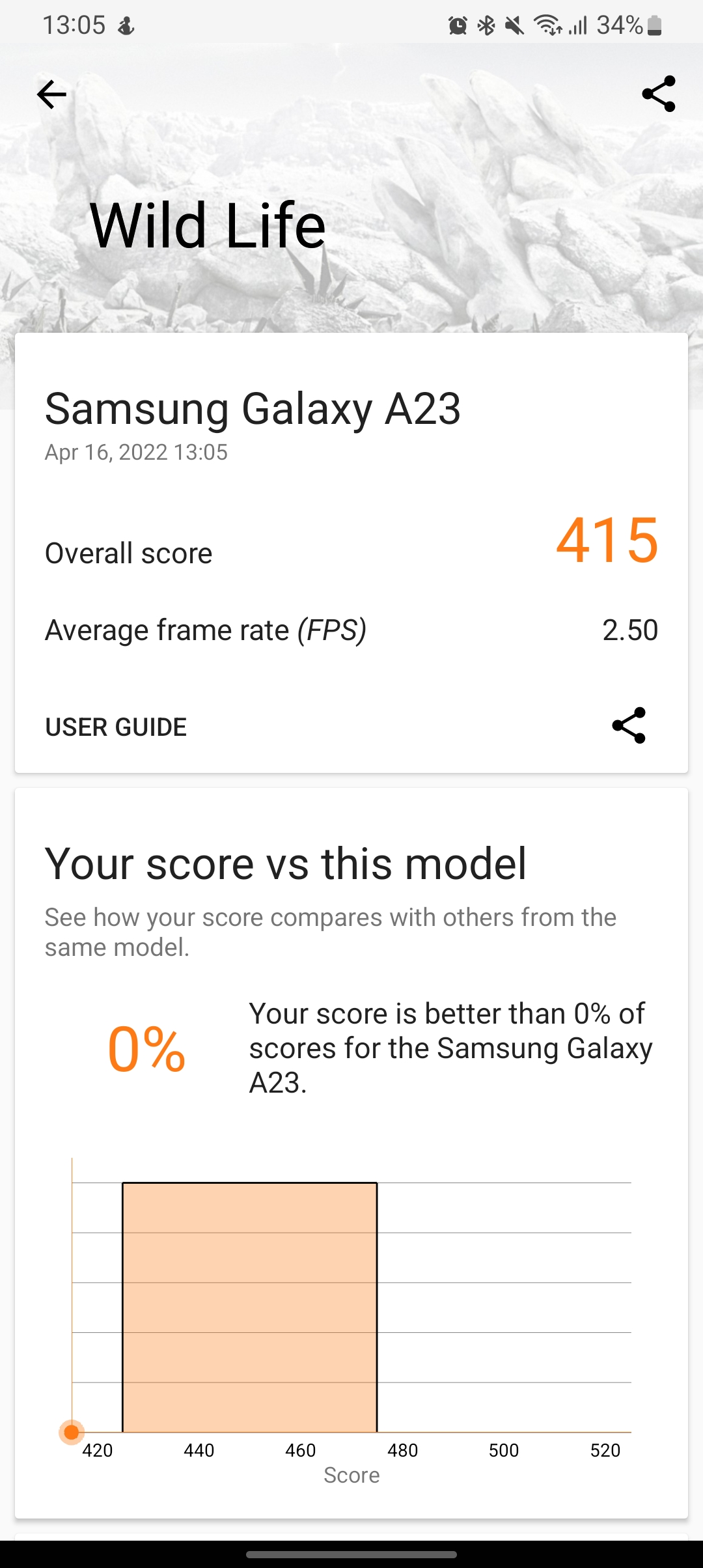Pros
- Good design
- Great battery life
- 90Hz display
- Fast charging support
- Decent main camera
Cons
- Dim PLS TFT display
- Subpar performance
- Disappointing ultrawide camera
- OIS does not work
- Poor value for money
- Outdated waterdrop notch
- Fast charger not provided with the device
Samsung announced five new devices to its A series portfolio last month, following the launch of its flagship S series. The Samsung Galaxy A23 is the least expensive device in the A series after the Galaxy A13, which is yet to launch in Nepal.

The Samsung Galaxy A23 price in Nepal is Rs. 25,999 for the 4/64GB variant and Rs. 29,999 for the 6/128GB variant.
It was initially priced at Rs. 2,000 higher, starting at Rs. 27,999. But Samsung later reduced the price of the device, presumably because Samsung recognised that the device was overpriced for what it offered.
So, is the phone worth buying after the price reduction? How does the phone perform, and how are its cameras? I’ll attempt to cover all of those in detail here in my Samsung Galaxy A23 review. Let’s start with the basics first: design and display.
Samsung Galaxy A23 Specifications
- Body: 164.5 x 76.9 x 8.44 mm, 195 g, Dual SIM (Nano-SIM, dual stand-by)
- Display: 6.6 inches TFT, 1080 x 2408 pixels, 90Hz
- Chipset: Qualcomm SM6225 Snapdragon 680 4G (6 nm)
- CPU: Octa-core (4×2.4 GHz Kryo 265 Gold & 4×1.9 GHz Kryo 265 Silver)
- GPU: Adreno 610
- Memory: 4/6/8GB RAM, 64/128GB Internal Storage (MicroSD slot up to 1TB)
- OS: Android 12, One UI 4.1
- Rear Camera: 50MP, F1.8, OIS
- 5MP Ultrawide, F2.2
- 2MP Macro, F2.4
- 2MP Depth, F2.4
- Video: 4k 30fps
- Front Camera: 8MP, f/2.2, (wide)
- Video: 1080p@30fps
- Battery: Non-removable Li-Po 5000 mAh Battery, Fast charging 25W support, 15W charger in the box
- USB: USB Type-C 2.0, USB On-The-Go
- Misc: Fingerprint (side-mounted), accelerometer, gyro, compass
- Colors: Black, White, Peach, Blue
Samsung Galaxy A23 Price in Nepal: Rs. 25,999 (4/64GB) | Rs. 29,999 (6/128GB)
Samsung Galaxy A23 Review
Design
- 164.5 x 76.9 x 8.44 mm
- 195 g
- Dual SIM (Nano-SIM, dual stand-by)

The design of the Samsung Galaxy A23 is very similar to other Samsung A series devices launched this year. The plastic back has a camera island that has five holes and soft edges that blends with the body, which we first saw on last year’s Samsung Galaxy A52 and Samsung Galaxy A72.
The device is available in four different colours: Peach, Blue, Black, and White. I have the Peach colour one and it looks very pleasing to the eyes. The colour matches throughout the back, rear camera island, and the curved frame of the device.

Because it has a glossy back, it attracts fingerprint smudges, but I found it to be less noticeable in this Peach colour. The device is quite big and the volume buttons are also placed slightly higher than I prefer, so it may be a bit uncomfortable for people with small hands.
Below the volume buttons on the right side of the phone is a power button that also serves as a fingerprint sensor. The sensor is easily reachable and is fast and reliable.
Thankfully, the Galaxy A23 still retains the 3.5mm headphone jack. Otherwise, Samsung no longer provides a headphone jack in its more expensive A series devices including the Samsung Galaxy A33 5G.
Looking at the front, the phone looks very outdated, with its waterdrop notch and a fairly large chin. Although the chin size is to be expected on a phone in this price range — though it could have been smaller — Samsung should have removed the V-cut notch. These days, even less expensive phones use a punch-hole design.
Display
- 6.6 inches PLS TFT LCD
- 90Hz
- 1080 x 2408 pixels
- Corning Gorilla Glass 5

I was expecting Samsung would provide an AMOLED display, but disappointingly, the Samsung Galaxy A23 comes with a PLS TFT display. Even its predecessor the Galaxy A22 had a Super AMOLED display but this year Samsung decided to downgrade the display panel.
On the other hand, the display’s resolution has been bumped up to Full HD+ (1080 x 2408 px) from last year’s HD+ display. This trade-off between a higher display resolution and an inferior display type simply isn’t worth it.
Even if we overlook the fact that it isn’t an AMOLED, the display isn’t really impressive. Samsung appears to have chosen the poorest sort of LCD panel for the Galaxy A23. With washed-out colours, the content on the display looks terrible for a phone at this price.
The display is a 90Hz panel. It would have been better if it had supported a 120Hz refresh rate like its competitors, but it did not bother me much. The usual scrolling and navigating through the OS felt smooth. And the refresh rate automatically drops to 60Hz when showing static images to save the battery.
Another disappointing aspect of the display is its brightness level. The display brightness is just enough for indoor usage. It’s not designed for outdoor use. I struggled to use the device outside in sunny conditions because of its low visibility due to inadequate brightness.
Camera
- Rear Camera: 50 MP (main), f/1.8, OIS
- 5 MP (ultrawide), f/2.2
- 2 MP (macro), f/2.4
- 2MP (depth), f/2.4
- Front Camera: 8MP, f/2.2

The Samsung Galaxy A23 features a quad-camera setup on the rear. The setup includes a 50MP Quad-Bayer primary camera with OIS, a 5MP ultra-wide-angle lens, a 2MP macro lens, and a 2MP depth sensor.
As mentioned, it has a dedicated depth sensor to help separate the subject from the background for the portrait shots. But unfortunately, it was not working in the review unit we got from Samsung. However, it should work in the retail unit.
NORMAL PHOTOS
The main camera takes good photos in daylight. It exposes the photos well with good details. The sharpness and clarity are not the best, but they do a decent job. And when zooming in, I noticed some noise, especially in the skies.
I also noticed that the colours of the photos are sometimes not consistent. It occasionally produced different colours in different photos of the same subject.
WIDE-ANGLE PHOTOS
Its predecessor Samsung Galaxy A22 had an 8MP ultrawide-angle camera, but the A23 has a 5MP one. The wide-angle shots are even noisier compared to the main camera. The photos come out darker with little details in the shadows. It also lacks good sharpness.
MACRO PHOTOS
The macro photos are not worth talking about. The colours are dull and the photos are soft. The inconsistency of the colours with the flowers can be seen in the sample photos. When I tried to take a macro shot of the red flower, it came out orange.
SELFIES
The 8MP front camera takes decent selfies. It exposes the subject properly and has a nice skin tone. But noise can be seen in the selfies, and the sharpness and clarity are also not that great.
VIDEO
It can shoot video at up to 1080p at 30fps. Samsung mentions that the main camera features optical image stabilization (OIS), but I found it to be useless as it seemed that it was not working as the video was very shaky.
When it comes to video quality, the colours aren’t that appealing, and the footage appears soft, which is to be expected for a phone in this price bracket.
Performance
- Qualcomm Snapdragon 680 4G (6 nm)
- Octa-core (4×2.4 GHz Kryo 265 Gold & 4×1.9 GHz Kryo 265 Silver)
- Adreno 610
- 64GB 4GB RAM, 128GB 6GB RAM
The Samsung Galaxy A23 is powered by Qualcomm Snapdragon 680 4G chipset, which is built on a 6nm process node. The same chipset powers the Realme 9i and the Redmi Note 11.
It features four performance Kryo 265 Gold (Arm Cortex-A73) cores running at up to 2.4GHz and four efficient Kryo 265 Silver (Arm Cortex-A53) cores running at up to 1.8GHz. And an Adreno 610 GPU.
I am using the 4GB variant with 64GB storage. You can also get the 6GB RAM variant that comes with 128GB storage. During my usage, I noticed frequent lags and delays.
While the phone was able to run the normal basic tasks just fine and scrolling through the apps was also smooth, the UI felt a little sluggish, and it took noticeably longer to open, close, or switch between apps. I also observed a few stutters here and there.
Additionally, I noticed lags when using the camera app, switching between lenses, and taking photos. It may be because the One UI 4.1 is too heavy for this phone and the 4GB RAM is insufficient. This could also be because I am using the review unit.
BENCHMARK TEST
For the CPU test, I ran the Geekbench 5 benchmark. The device scored around 375 points on a single-core performance test and scored close to 1500 points on a multi-core performance test.
On 3D Mark (Wild Life) benchmark, which tests the graphics performance using Vulkan graphics API, it received a score of around 415. The scores are just average.
The similarly priced Narzo 50, which is powered by a more powerful MediaTek Helio G96 chipset, offers superior CPU and GPU performance.
GAMING
I played PUBG Mobile on the Galaxy A23. The Graphics could only go as high as “Balanced”, on which the Frame Rate was limited to just “Medium”. By switching to “Smooth” Graphics, the Frame Rate could be set to “High.”

I played the game in the latter configuration, in which it delivered a stable 30fps gameplay with a few stutters here and there. The small stutters were more noticeable in the Classic mode than in the Arena mode.
I also played another popular shooting game, Free Fire. The Graphics was set to “Ultra” while I left all the other settings to their default. I was getting an average of 30 frames per second but was getting fewer stutters than in PUBG Mobile.

It’s already clear that the device is not for gamers. Nevertheless, I tested another very high graphics-intensive game Genshin Impact. The Graphics Quality was set to “Low (Default)” and, to no surprise, a lot of stutters were observed with an unplayable 11 frames per second (average).

Battery and Others
- Non-removable Li-Po 5000mAh battery
- 25W Fast Charging support
- Android 12, One UI 4.1

The battery life on the Samsung Galaxy A23 is great. Even for heavy users, this phone should easily last a day on a single charge.
I was getting over 8 hours of screen-on-time during my light usage, whereas playing games for a couple of hours dropped that to around 6-7 hours.
It’s a 5,000mAh battery and it supports 25W fast charging. But unfortunately, Samsung only provides a 15W charger with the phone. With a fast charger, the phone takes around 1.5 hours to fully charge from 0%.
In terms of software, it boots on One UI 4.1 based on Android 12 out-of-the-box. The One UI experience is clean and easy to navigate. I did not find any noticeable issues other than the already mentioned lags.
There is a single down-firing speaker on the Galaxy A23. The speaker gets sufficiently loud and the sound quality is average for the price.
Should You Buy the Samsung Galaxy A23?
Initially, the Samsung Galaxy A23 was priced at Rs. 27,999 (Now Rs. 25,999) for the 4/64GB variant and Rs. 32,000 (Now Rs. 29,999) for the 6/128GB variant. The phone was clearly overpriced in comparison to what it offered, and Samsung was well aware of this. So, Samsung later reduced the price of the Galaxy A23 by Rs. 2,000 across both variants.
Still, I don’t feel like it offers a good value for money. So, I would not recommend buying the Samsung Galaxy A23 in 2022. The display is subpar, the performance is disappointing, and the cameras are underwhelming, especially the ultrawide one.
The battery, on the other hand, is really great and supports 25W fast charging, but the phone box includes only a 15W charger. The back design looks nice, but the front is clearly outdated with its waterdrop notch.
The Realme Narzo 50 is a great alternative to this phone, which has a more capable chipset, better display, and better design. There is also the Redmi Note 11, which is powered by the same Snapdragon 680 4G processor as the Galaxy A23 but offers a superior AMOLED display panel.
The Realme 9i is also powered by the same Snapdragon 680 chipset, which may not be as appealing as the Narzo 50 or the Redmi Note 11, but is an overall good device. Its predecessor Realme 8i, however, is another great alternative which is identical to the Narzo 50 but offers slower charging.
All of the devices mentioned above cost less than the Samsung Galaxy A23.
READ NEXT: Samsung Mobiles Price in Nepal: Features and Specs
What do you think about the Samsung Galaxy A23? Let us know in the comments!
Also, watch our review of the Samsung Galaxy M33 5G in Nepali.
One Comment
Leave a Reply
-
TechLekh Awards: Best Bikes of 2025 in Nepal Winners!Motorcycling in Nepal has always meant more than just getting from one place to another.…
-
TechLekh Awards: Best Cars of 2025 in Nepal Winners!Electric vehicles continue to dominate Nepal’s market in 2025, and Chinese manufacturers still lead the…
-
Much-Awaited TVS Apache RTX 300 to Launch in Nepal This YearHIGHLIGHTS TVS Apache RTX 300 price in Nepal is expected to be between Rs. 6.50…
-
Tata Harrier EV Becomes One of India’s Best-Selling EVs, But When Will It Arrive in Nepal?HIGHLIGHTS Tata Harrier EV price in Nepal is expected to start between Rs. 65 Lakhs…
-
Global Accessory Brand ‘Oraimo’ Officially Launches in Nepal with 12 ProductsA new player has officially entered Nepal’s mobile accessories market, and it’s already making a…




























Don’t ever buy this device, 1.5 month of usage the display went off and when I visited the service center they told water has entered the device which i no is not correct. They are asking for 14k to fix the device which is under warranty.
Not sure what kind of quality Samsung is putting in the product that its so delicate and not sturdy at all, Rs 17,000 went total waste.
Never ever buy Samsung products …total crap